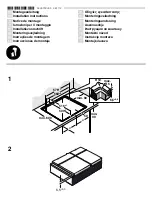
26
Solutions to Common Problems
Before you call...
If you experience a concern with your refrigerator or notice a product behavior or condition that you do not understand, you
can usually avoid a call to your service representative by referring to this section for an answer. Beginning with the following
table, this information includes concerns, potential causes, and common solutions.
Odors In Refrigerator
Concern
Potential Cause
Common Solution
Interior is dirty.
Odors
Interior needs to be cleaned.
Food with strong odors is stored in
refrigerator.
See Care & Cleaning Tips.
Cover food tightly. Air fi lter may need to be
changed more frequently if foods with strong odors
are routinely stored in refrigerator.
Automatic Ice Maker
Concern
Potential Cause
Common Solution
Ice maker is not making
any ice.
• Ice maker is turned off.
• Refrigerator is not connected to water line or
water valve is not open.
• The water supply line is kinked.
• The water fi lter is not seated properly.
• The water fi lter may be clogged with foreign
material.
• Saddle valve on cold water pipe is clogged
or restricted by foreign material.
• Turn on ice maker by lowering the wire signal arm.
• Connect the unit to the household water supply and
ensure the supply valve is open.
• Ensure that the supply line does not kink when the
refrigerator is pushed into place against the wall.
• Remove and re-install the water fi lter. Be sure to push
the fi lter fi rmly so that you hear it lock solidly into
position.
• If water dispenses slowly or not at all, or if the fi lter is
six months old or older, it should be replaced.
• Turn off household water line valve. Remove valve.
Ensure that valve is not a self-piercing saddle valve.
Clean valve. Replace valve if necessary.
Ice maker is not making
enough ice.
• Ice maker is producing less ice than you
expect.
• The water fi lter may be clogged with foreign
material.
• The water supply line is kinked.
• Saddle valve on cold water pipe is clogged
or restricted by foreign material.
• Heavy traffi c, opening or closing of the
doors excessively.
• Freezer control is set too warm
• Water pressure is extremely low. Cut-off
and cut-on pressures are to low. (well
system only)
• Reverse osmosis sytem is in regenerative
phrase
• The ice maker will produce approximately 2 to 2.5
lbs (0.9 to 1.1 kg) of ice every 24 hours depending
on usage conditions.
• If the fi lter is six months old or older, it should be
replaced.
• Ensure that the supply line does not kink when the
refrigerator is pushed into place against the wall.
• Turn off household water line valve. Remove
valve. Ensure that valve is not a self-piercing
saddle valve. Clean valve. Replace valve if
necessary.
• Press Fast Freeze to temporarily increase ice
production rate.
• Set freezer control to colder setting to improve
performance of the ice maker. ALlow 24 hours for
temperature to stabilize.
• Have someone turn up the cut-off and cut-on
pressure on the water pump system (well system
only)
• It is normal for a reverse osmosis system to be
below 20 psi during the regenerative phase.
Freezer ice maker will not
stop making ice.
• Ice maker wire signal arm is being held
down by some package in the freezer that
has fallen against the ice maker.
• Move the item and release wire signal arm. Remove
any ice cubes that may have frozen together over the
wire signal arm.
Ice cubes are freezing
together.
• Ice cubes are not being used frequently
enough.
• Ice cubes are hollow (shells of ice with
water inside). The hollow cubes break open
in the bin and leak their water onto existing
ice, which causes it to freeze together.
• Remove ice container and discard ice. The ice maker
will produce fresh supply. Ice should be used at least
twice weekly to keep the cubes separated.
• This generally occurs when the ice maker does not
get enough water. This is usually the result of a
clogged water fi lter. Replace the water fi lter.
















































